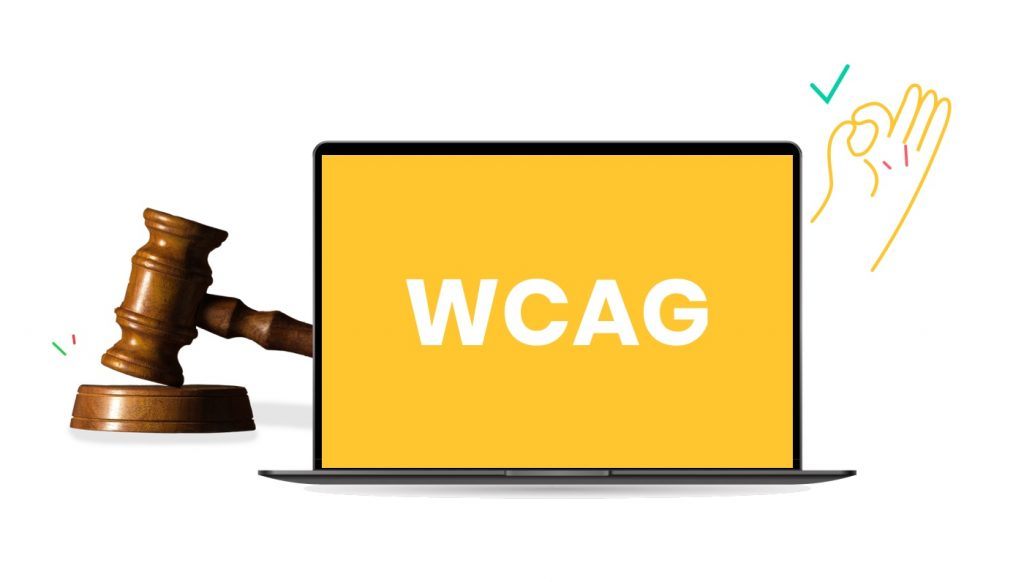This is what you need to know about the WCAG guidelines

As a digitally accessible (online) company, you must comply with the guidelines of the international Web Content Accessibility Guidelines. We explain how WCAG ensures digital accessibility and what steps you can take with your organization.
What you need to know about the WCAG guidelines
Digital accessibility is a crucial aspect of modern websites and apps! The Web Content Accessibility Guidelines (WCAG) are international standards that help developers and businesses make digital platforms accessible to everyone, including people with disabilities.
However, these guidelines are not only intended for developers but also for designers, content managers, and policymakers involved in digital products and services.
Established by the World Wide Web Consortium (W3C), these guidelines outline the technical and functional requirements that websites and applications must meet to be user-friendly for a broad audience.
Why is digital accessibility important?
The internet plays an essential role in our daily lives, from online shopping to banking and working.
For people with visual, auditory, motor, or cognitive disabilities, a poorly designed website can be a significant barrier!
By following the WCAG guidelines, you ensure that your digital tools are accessible to everyone. Additionally, an accessible website enhances user experience, broadens your reach, and strengthens your reputation.
In many countries, including Belgium and the Netherlands, digital accessibility is even legally required for government websites and public services.

Four key principles
The WCAG standards are based on four principles:
This means that content must be clear for different users, interfaces must be easy to operate (e.g., with a keyboard or screen reader), and websites must function robustly across various devices and browsers.
What developers should consider:
- Providing alternative text (alt text) for images to assist blind and visually impaired users.
- Structuring HTML correctly to enable easy navigation with screen readers.
- Ensuring sufficient contrast between text and background for readability.
- Avoiding flashing elements that could trigger epileptic seizures.
By following the WCAG guidelines, you not only make your website more inclusive but also improve its overall quality and usability. In the end, every user—whether with or without a disability—benefits from a more accessible digital experience.
WCAG as the foundation for the EAA
The European Accessibility Act (EAA), also known as the European Accessibility Law, aims to make digital media—such as websites, webshops, and apps—more accessible and inclusive. The EAA is a legal requirement that compels organizations within the EU to meet specific accessibility standards.
It focuses on creating an inclusive market by providing legal guidelines for the accessibility of a wide range of products and services. The legislation associated with the EAA is based on the WCAG guidelines.
In short: the EAA sets the legal obligations, while WCAG serves as the technical roadmap for implementing these requirements in practice.
June 28, 2025, is a crucial date related to the EAA. Read our article on the European Accessibility Act to understand why this deadline is essential for businesses.
Is WCAG mandatory?
The requirement to comply with WCAG guidelines varies by country. In some countries, such as the United States, Canada, and the United Kingdom, there are strict accessibility laws that mandate digital accessibility for businesses and government agencies.
In the United States, for example, this falls under the Americans with Disabilities Act (ADA) and Section 508, while in Canada the Accessible Canada Act (ACA) applies.
For companies in the private sector, the obligation varies depending on the legislation in the country in question. However, large companies operating in the international market are increasingly confronted with legal claims when their websites do not meet accessibility standards.
Guidelines within the EU and Belgium
Within the European Union, WCAG guidelines are legally embedded in the European Accessibility Act (EAA) and the EN 301 549 standard. This legislation requires government websites and certain commercial sectors (such as e-commerce and financial services) to meet at least WCAG 2.1 Level AA.
In Belgium, digital accessibility is mandatory for government agencies and public organizations under the Law on Digital Accessibility. This means that federal, regional, and municipal government websites must comply with WCAG 2.1 AA.
For private businesses, compliance is not yet a universal obligation. However, starting in June 2025, the European Accessibility Act will make accessibility mandatory for sectors such as banking, e-commerce, and transportation.
Fines, sanctions, and reputation damage
Failure to comply with WCAG guidelines can have various consequences, depending on the sector and country:
Failure to comply with the WCAG guidelines can have various consequences, depending on the sector and the country. In the public sector, fines or sanctions can be imposed if government websites do not meet the legal accessibility requirements.
In the private sector, companies can face lawsuits and claims for damages from users who are disadvantaged by inaccessible websites.
In addition, an inaccessible website can lead to reputational damage and loss of customers, because more and more consumers and companies value inclusiveness and user-friendliness.
Companies and organisations that strive to comply with WCAG guidelines reduce the risk of legal liability and at the same time strengthen their market reach and reputation.

Key benefits of WCAG
The primary benefit of the WCAG guidelines is ensuring that websites and apps are accessible to everyone, including individuals with disabilities. Consider users with visual, auditory, motor, and cognitive impairments.
By providing alternative text for images, captions for videos, and a clear navigation structure, more people can easily use digital content. This increases their independence and improves their online experience.
For many businesses and organizations, especially in the public sector, compliance with WCAG 2.1 AA or WCAG 2.2 is a legal requirement. In the European Union, government bodies and public services are required to comply with accessibility standards according to the European Accessibility Act and the EN 301 549 standard.
By following these guidelines, organizations avoid legal risks and demonstrate social responsibility.
An accessible website benefits not only users with disabilities but also search engines like Google. Many accessibility improvements, such as clear headings, semantically correct HTML, and fast load times, contribute to better SEO rankings.
This ensures that a website ranks higher in search results and is more easily found by a broader audience. Furthermore, these adjustments enhance overall user experience (UX), resulting in lower bounce rates and higher conversions.
By improving digital accessibility, you automatically reach a larger group of users. This includes not only people with disabilities but also elderly individuals, mobile users, and people with temporary limitations (such as a broken arm or strong sunlight on their screen).
Companies investing in WCAG guidelines can appeal to a larger potential customer base and stand out from competitors who have not yet addressed accessibility.
The different WCAG updates
The WCAG guidelines were first published in 1999 by the W3C’s Web Accessibility Initiative (WAI). The aim was to introduce a universally applicable set of guidelines enabling web developers to make their websites accessible.
Since then, several updates have been made to improve and adapt the guidelines to new technologies. Here are the most significant:
What are the different levels?
The WCAG standards are divided into three levels: A, AA, and AAA. These levels indicate the strictness of the accessibility requirements.
Accessibility requirements by level
The accessibility requirements vary by level and focus on different website aspects:
- Level A: Basic requirements, such as keyboard navigation and alternative text for images.
- Level AA: Additional measures, like sufficient color contrast and clear focus indicators for interactive elements.
- Level AAA: Strict rules, such as even higher contrast levels and alternative formats for complex content, like sign-language videos for all spoken content.
WCAG 2.1 AA guidelines for government websites
All websites and mobile apps of government organizations must comply with the WCAG 2.1 guidelines up to level AA under the terms of the European Standard for digital accessibility (EN 301 549V1.1.2).
Key aspects of the WCAG 2.1 guidelines:
Government bodies must actively monitor and improve their websites and mobile applications to remain accessible to all citizens.
What about WCAG 2.2?
WCAG 2.2 is the latest version of accessibility guidelines, building upon WCAG 2.1 AA guidelines. This update primarily focuses on improving accessibility for individuals with cognitive disabilities, motor impairments, and mobile users.
The main changes in WCAG 2.2 include additional guidelines for:
- User-friendly focus indicators, allowing individuals navigating via keyboard or assistive devices to clearly see their location on a page.
- Accessibility of interactive elements, such as buttons large enough to easily tap on mobile devices.
- Avoiding unnecessary re-authentication, so users with cognitive impairments do not repeatedly need to enter complex passwords.
Although WCAG 2.2 is not yet incorporated into all legislations, it is recommended for new websites and applications and will gradually play a significant role for government websites and organizations preparing for stricter accessibility standards.
While it cannot yet be stated with absolute certainty, there is a strong likelihood that WCAG 2.2 will form the basis for the European Accessibility Act (EAA).

How do you know if your website or app meets accessibility standards?
The WCAG guidelines contain a series of success criteria that determine whether a website or application complies with the accessibility standards. These success criteria are objectively measurable and are assessed on the basis of three levels: A, AA and AAA.
By meeting these criteria, websites become accessible to a broader audience and comply with legal requirements.
Assessment typically involves automated accessibility tests and manual evaluations. Automated tools like WAVE or Axe quickly detect technical errors, but a thorough manual review is necessary to ensure the website is genuinely usable by people with disabilities.
Difference between mandatory and optional criteria
Not all WCAG criteria are mandatory in practice. Level A and AA guidelines are compulsory for most organizations and public bodies subject to accessibility legislation.
Level AAA guidelines are recommended but not obligatory, as they are often difficult to implement fully without significantly changing a website's design or functionality.
For example, the requirement for text to have a contrast ratio of 7:1 instead of the standard 4.5:1 (AA level).
Tip: Use a WCAG Checker for color contrast
One of the most important accessibility requirements is sufficient contrast between text and background, ensuring readability for all users, including those with visual impairments. You can quickly and easily verify this using a WCAG checker for contrast, such as WebAIM Contrast Checker or Color Contrast Analyzer.
These tools immediately show if your color combinations meet WCAG 2.1 levels AA or AAA and suggest improved color values if your contrast is insufficient. This ensures your website is accessible and readable to a broader audience.

Some common WCAG success criteria include:
WCAG Evaluation Methodology (WCAG-EM)
The WCAG Evaluation Methodology is the standard method for web accessibility evaluation.
WCAG-EM is a structured approach to assess if a website meets WCAG guidelines. Developed by the World Wide Web Consortium (W3C), it helps organizations systematically test digital accessibility.
WCAG-EM combines automated scans, manual evaluations, and user testing. By following this method, organizations gain comprehensive insights into their website’s accessibility, allowing targeted improvements.
When are you WCAG-proof?
A website is considered WCAG-proof when it meets required accessibility standards, usually at level AA. This means the site is accessible to people with various disabilities and compatible with assistive technologies such as screen readers and keyboard navigation.
Being WCAG-proof is not only a technical requirement but also a quality mark. It demonstrates an organization's commitment to inclusivity and user-friendliness, positively impacting brand perception and customer trust.
How to verify if your site complies with the guidelines?
Several ways exist to verify if a website is WCAG-proof:
WCAG-proof with AccessiWay
You can collaborate with an external partner to enhance the accessibility of your products and services efficiently and cost-effectively. AccessiWay is the ideal solution!
This accessibility tool ensures your website is usable by all visitors. AccessiWay, part of team.blue—which includes Combell—offers a simple and effective method for improving digital accessibility.
With the addition of a convenient widget, AccessiWay helps you with:
- Improved readability
- Optimized colors and contrasts
- Enhanced support for screen readers
- ...
Additionally, the tool performs daily scans, continuously optimizing the content of your website or webshop.
Are you interested in making your online tools WCAG-proof and curious about how AccessiWay can support you?


